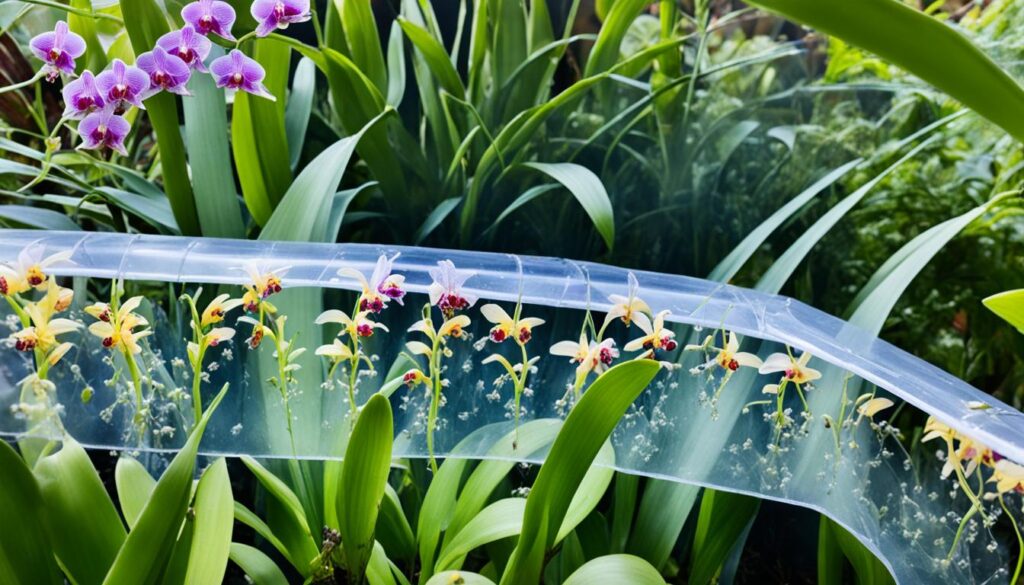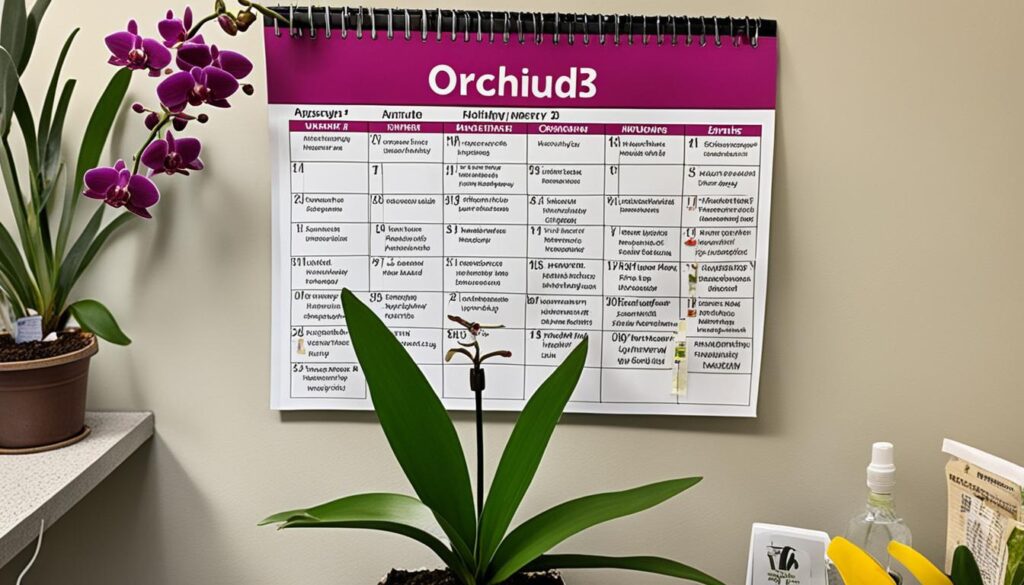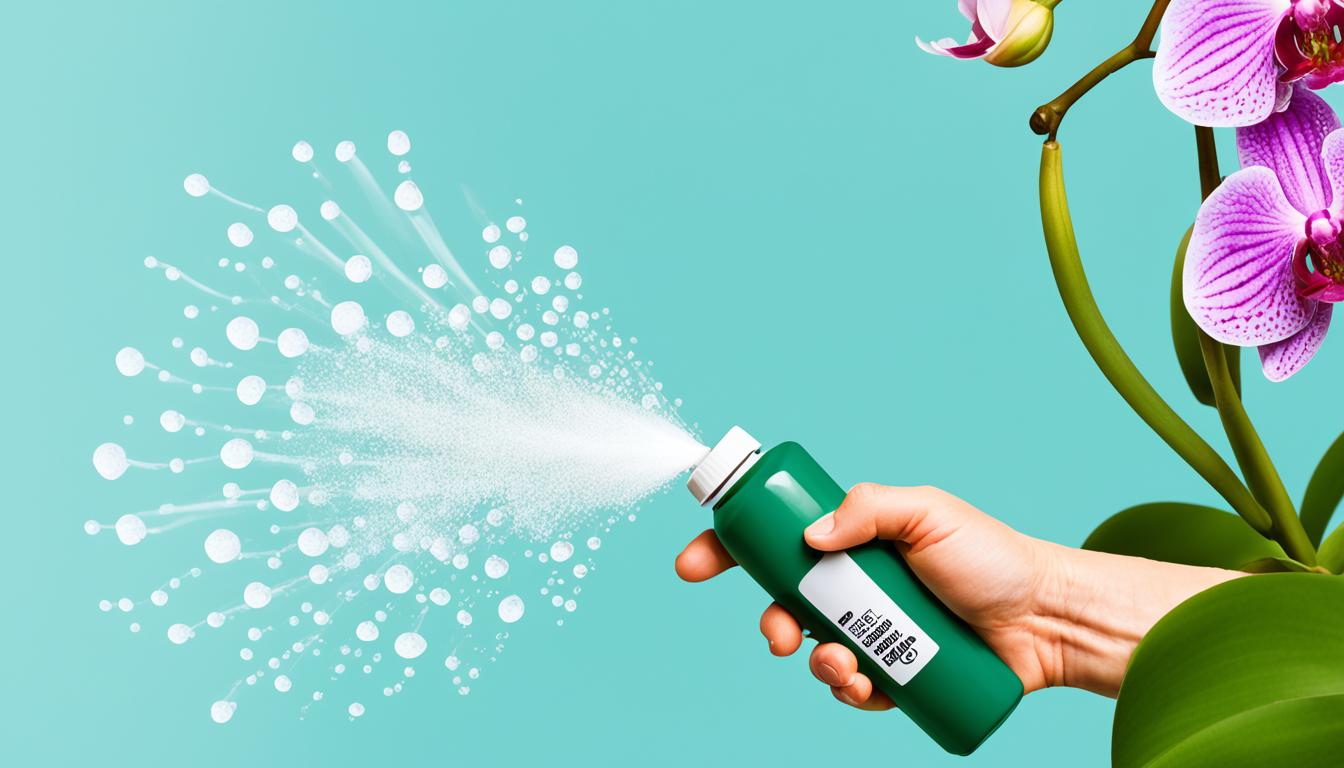Did you know that there are over 270,000 species of flowers in the world, but one insidious pest is enough to threaten the health of the exquisite orchids among them?
Mealybugs are small but formidable adversaries, which, if left unchecked, can overthrow the well-being of any orchid enthusiast’s collection. As an orchid devotee myself, I’ve seen firsthand the havoc these pests can wreak.
Fuelled by an undying passion for orchid care, I’ve honed my expertise in orchid pest management to provide fellow growers with crucial tips to eradicate mealybugs and ensure the prosperity of their irreplaceable plants.
In the universe of ornamental horticulture, mealybugs are a formidable force. They aren’t your typical garden nuisances; these bugs mount a full-scale assault on the health and beauty of your orchids.
Imagine watching helplessly as these unwelcome guests turn your prized orchids into their feeding grounds. But despair not, armed with the right mealybug control strategies; you can safeguard your treasured plants and restore their luster.
Key Takeaways
- Understand that rapid response is critical in preventing mealybug infestations from causing irreversible damage to orchids.
- Learn to recognize the telltale signs of mealybug presence, such as the cotton-like clusters on your precious orchids.
- Isolation is key, quarantine infested orchids to halt the threat mealybugs pose to the rest of your collection.
- Home remedies can be effective, particularly when it comes to mealybug eradication, with rubbing alcohol being a highly recommended option.
- For persistent infestations, be prepared to employ chemical insecticides with caution, or opt for natural mealybug sprays as an eco-friendly alternative.
- Maintain rigorous orchid care practices post-treatment to prevent reinfestation and promote long-term, mealybug-free orchid health.
- Remember that consistent management and understanding of mealybug behavior are indispensable for effective pest management.
Understanding the Threat of Orchid Mealybugs
As I delve deeper into the world of orchid care, it becomes increasingly evident how mealybugs pose a severe risk to these delicate plants.
My focus today is on identifying mealybugs, understanding various orchid mealybug species, and recognizing the mealybug infestation signs.
Correct identification and early detection are crucial in preserving the health and beauty of orchids.
Identifying Mealybugs on Your Orchids
When I examine my orchids for pests, I look for telltale marks of mealybug activity. These pests are small, segmented insects covered in a wax-like substance, making them appear as tiny cotton-like blobs nestled in the nooks of plant stems and leaves.
Their inclination to hide in sheltered spots calls for thorough inspection, especially around the roots and the underside of leaves where they might escape a cursory glance.
Common Mealybug Species and Their Characteristics
- Longtailed Mealybug (Pseudococcus longispinus): Distinct for its extended wax filaments resembling a tail, making it one of the easier species to identify.
- Orchid Mealybug (Pseudococcus orchidicola): As the name suggests, these are commonly found on orchids and can be particularly stubborn to eradicate due to their adaptability.
- Imported Mealybug (Planococcus citri): Known for their high reproductive rate, they can rapidly colonize and damage a wide range of plants, not just orchids.
To illustrate further, let’s compare some additional mealybug variants I’ve encountered on orchids:
| Species | Region | Color | Notable Features |
|---|---|---|---|
| Dendrobium Mealybug (Antonina graminis) | California, Hawaii | White to Pink | Prefers to infest grass-like orchids such as Dendrobium |
| Pineapple Mealybug (Dysmicoccus brevipes) | California, Hawaii | Grey | Can spread pineapple wilt virus among other plants |
Recognizing Early Warning Signs of Infestation
When I teach fellow orchid enthusiasts about mealybug infestation signs, I stress the importance of early intervention. Sometimes, the first clue is a sticky substance known as honeydew, which can lead to sooty mold.
Another early sign includes discolored patches where the bugs have fed. I always advise keeping an eye out for a white powdery residue that could indicate a mealybug presence before the infestation becomes visible and widespread.
Awareness and prompt action are vital in combating these pests and keeping our precious orchids safe.
Immediate Measures for Mealybug Containment
When I discover mealybugs on my orchids, my first line of defense is to immediately isolate the invaded plant. This is a critical step to prevent mealybug spread and protect my surrounding plants.
During quarantine, I perform a detailed inspection beneath the leaves and in all the nooks and crannies. If it’s an early infestation, I apply treatments right there on the spot.
For a quick containment solution, I’ve found that using rubbing alcohol or a homemade mix of water-based cinnamon herbal infusion with a touch of baby shampoo works wonders.
This concoction, when applied directly, has proven effective against mealybugs and isn’t harmful to the orchids.
By quarantining infested orchids, I not only control the outbreak but also shield my healthy plants from potential harm.

- Inspect the orchid for all signs of infestation.
- Quarantine immediately to avoid spread to other plants.
- Apply a mixture of rubbing alcohol or cinnamon-water solution with surfactant.
- Monitor the orchid daily for any signs of persistent mealybugs.
Fighting mealybugs necessitates a multi-pronged strategy. Let’s break down the containment process into actionable steps and identify what works best:
| Action | Advantages | Likely Outcome |
|---|---|---|
| Isolate and inspect the affected orchid | Stops immediate spread to other plants, establishes treatment focus. | Infestation contained to a single plant, making management more feasible. |
| Apply rubbing alcohol directly | Quick-acting on contact, eliminates adults and nymphs. | Majority of mealybugs are eradicated after repeated treatments. |
| Use a water-based herbal infusion | Natural and less harsh on orchids, promotes a healthier plant environment. | Gradual reduction in mealybug population, fosters healthier growth post-infestation. |
By diligently following these mealybug containment measures, I’ve managed to save many orchids from the brink of demise. It’s a testament to the fact that with timely intervention and the right tactics, even a severe mealybug onslaught can be subdued.
Home Remedies vs. Chemical Solutions
As I delve into the pesky world of mealybugs, I understand that the choice between home remedies and chemical solutions becomes a pivotal decision in safeguarding my orchids.
Let’s explore the efficacy of various methods including the tried-and-true rubbing alcohol, widely available chemical insecticides, and the environmentally kind natural sprays.

Using Rubbing Alcohol for Mealybug Removal
I’ve personally found that rubbing alcohol is a reliable ally in the fight against mealybugs. A solution crafted from isopropyl alcohol diluted with water, a squirt of liquid soap, and sometimes a touch of oil can be extremely effective.
This concoction, when applied directly to the infected areas, can quickly reduce the population of these pests.
Pros and Cons of Chemical Insecticides
Chemical insecticides are potent against mealybug infestations, especially those that have stubbornly resisted home interventions.
However, while their effect is often immediate and far-reaching, I always weigh the pros and cons.
These chemicals can impact the broader ecosystem and beneficial insects, so caution is paramount.
Natural Sprays and Their Effectiveness Against Orchid Mealybugs
My commitment to environmental stewardship often guides me towards natural sprays as an alternative, such as a cinnamon-infused solution.
These sprays are gentler on the plants and non-toxic to humans and pets, which earns them a favored spot in my orchid care toolkit.
| Treatment Type | Key Ingredients | Frequency of Application | Eco-Friendly | Precautionary Measures |
|---|---|---|---|---|
| Home Remedy | Rubbing alcohol, water, soap, oil | As needed | Yes | Check for plant sensitivity |
| Chemical Insecticides | Various chemical compounds | Read label instructions | No | Use in well-ventilated areas; follow safety guidelines |
| Natural Sprays | Cinnamon oil, water, soap, alcohol | Every 10-14 days | Yes | Consistency is crucial for effectiveness |
Maintaining Your Orchids Mealybug-Free
Maintaining a mealybug-free orchid collection requires diligence and an effective maintenance regime. After successfully dealing with an infestation, it’s imperative to protect your orchids against future threats.
I prioritize orchid maintenance, guaranteeing my plants are provided with a pest-free environment to thrive in.
Here’s how I maintain the health and beauty of my orchids post-mealybug treatment, ensuring that these ornate plants remain vibrant and vigorous.
- Repotting: Start by repotting your plants in fresh, sterile potting medium post-eradication. It’s an essential step to prevent dormant mealybugs from rebounding.
- Cleaning: I make it a routine to keep both my orchids and their environment pristine. Using natural cleaners helps ward off potential pest intruders and sustains a healthy growing area.
- Isolation: When I introduce new plants to my collection, isolation is key. It allows me to observe them for pests before integrating them with established plants.
- Pest Control Systems: Natural pest control options like GET OFF ME! Natural Pest Control Spray are indispensable allies. These sprays reinforce the plant’s defenses without adding harmful chemicals to the mix.
These steps have become an integral part of my routine to sustain a thriving, mealybug-free orchid collection.
Below is a table that summarizes my weekly maintenance schedule:

| Day of the Week | Activity | Details |
|---|---|---|
| Monday | Visual Inspection | Check for signs of pests or disease, focusing on undersides of leaves and roots. |
| Wednesday | Cleaning Foliage | Apply natural leaf cleaner to foliage, avoiding flower petals. |
| Friday | Environmental Tidying | Clean surrounding area and remove any fallen plant debris. |
| Sunday | Preventative Spray | Apply GET OFF ME! Natural Pest Control Spray as a preventive measure. |
By adhering to this schedule, I assure my precious orchids remain in optimal health, diminishing the potential for future pest infestations.
As a result, my orchids are not only surviving but truly flourishing in a mealybug-free environment.
Professional Insights on Mealybug Lifecycle and Propagation
As a professional horticulturist, gaining an in-depth understanding of the mealybug lifecycle is indispensable in combating these pests effectively.
These insects can wreak havoc in greenhouses, but with the right knowledge, greenhouse pest control can be more systematic and successful.

Importance of Understanding Mealybug Lifecycle for Effective Control
The intricacies of mealybug behavior during their egg, larva, and adult stages necessitate targeted control strategies. Each stage offers unique challenges and control opportunities.
For example, treating during the larval stage, when mealybugs are most mobile and exposed, can curb an infestation more effectively than targeting the more protected egg or adult stages.
Strategies to Prevent Mealybug Spread in Greenhouses
- Regular Monitoring: Keen observation for any signs of an infestation, especially along pot rims and plant crevices.
- Cultural Controls: Employing sanitation practices and removal of infested plant material promptly.
- Biological Controls: Introducing beneficial predators like ladybugs or applying microbial insecticides.
- Physical Barriers: Using screens and sticky traps to limit mealybug movement and spread.
Mealybug Behavior and the Best Times to Apply Treatments
Understanding when mealybugs are most vulnerable and active is crucial for the timing of treatments. Here is a simplistic timetable that outlines the best times for intervention:
| Stage | Best Time for Treatment | Recommended Controls |
|---|---|---|
| Egg | Pre-hatch | Temperature regulation, biological controls |
| Larva (Crawlers) | Shortly after hatching | Insecticidal soap, neem oil, physical removal |
| Adult | Before egg-laying | Systemic insecticides, natural predators |
By aligning treatments with these stages, greenhouse owners can optimize their control measures and mitigate the resilient nature of mealybugs.
Conclusion
In sum, mastering effective mealybug control is an essential component of consistent orchid care. It’s not merely about reacting swiftly when pests are detected, but about embracing an integrated approach to prevent infestations. Isolating affected plants, employing a combination of home remedies, and, if necessary, complementing with chemical insecticides, are vital to safeguarding the health of your prized orchids.
Summary of Effective Control Tips for Orchid Mealybugs
As part of your arsenal, utilizing natural sprays and insecticides strategically can help manage these pests.
Acknowledging that mealybugs are a formidable enemy, my recommendation is to stay vigilant and respond proactively at the first sign of trouble.
Repeating treatments and regularly inspecting your orchids for signs of pests will help in maintaining a healthy garden.
Why Consistent Management is Key to Protecting Your Orchids
Moreover, dedication to consistent orchid care is paramount. By establishing a routine of thorough monitoring and meticulous treatment application, the chances of mealybug issues significantly decrease.
This consistent management strategy plays a fundamental role in the long-term health and vigor of your orchids, keeping them robust enough to naturally deter pests.
Encouraging Vigorous Plant Health to Deter Pests
In my experience, nothing beats the defense mechanism of a healthy plant. Fostering strong, vigorous orchid growth through optimal care practices and nurturing their resilience will yield an environment less conducive to mealybug establishment.
Remember, the goal is to create not just a mealybug-free environment today but to promote orchid health that lasts a lifetime.
FAQ
How can I identify mealybugs on my orchids?
You can identify mealybugs by their cotton-like appearance, which may be white, yellowish-white, whitish-grey, or pale pink to pale blue, and they often conceal themselves in the roots, crevices, or the underside of leaves. Look for cottony clusters or powdery residue as initial signs of their presence.
What are some common mealybug species that attack orchids?
Common species include the longtailed mealybug, orchid mealybug, and imported mealybug. In regions like California and Hawaii, the dendrobium mealybug and pineapple mealybug are also prevalent.
What should I do immediately after spotting mealybugs on my orchids?
Immediately isolate the infested orchid to prevent the spread of mealybugs. Inspect the plant thoroughly, including hidden spots and crevices, and consider applying a water-based cinnamon herbal infusion with baby shampoo or rubbing alcohol to control the infestation early on.
Can I use rubbing alcohol to treat mealybugs on orchids?
Yes, rubbing alcohol is an effective home remedy for treating mealybugs. It can be mixed with water, liquid soap, and sometimes a mild oil to enhance coverage. Apply it directly to the pests, and repeat treatment every 10-14 days to break their lifecycle.
Are chemical insecticides necessary for controlling mealybugs?
While home remedies can be effective, more severe infestations may require the use of chemical insecticides. These should be used with caution and as per the instructions to avoid harming your orchids or the environment.
How can I keep my orchids mealybug-free after treatment?
To maintain a mealybug-free environment, repot the orchid in fresh soil, keep the plant and surrounding area clean, and use natural leaf cleaners or sprays like GET OFF ME! Natural Pest Control Spray. Isolate new plants, and be vigilant with plant care to prevent reinfestation.
Why is understanding the mealybug lifecycle crucial for effective control?
Knowing the mealybug lifecycle, which includes egg, larva, and adult stages, is essential to timing treatments effectively. This understanding helps disrupt their breeding cycle and prevents their population from growing in your orchid collection.
What strategies can help prevent mealybug spread in greenhouses?
Implementing good cultural practices, introducing natural predators, using biological controls like insecticidal soap or neem oil, and applying necessary systemic insecticides can help. Also, regular monitoring and greenhouse maintenance are key to containing mealybug spread.
When is the best time to apply treatments to control mealybugs?
The best times to apply treatments are when mealybugs are most active and vulnerable, typically during the early stages of their lifecycle before they can reproduce. Consistent application every 10-14 days can effectively control their population.


Leave a Reply